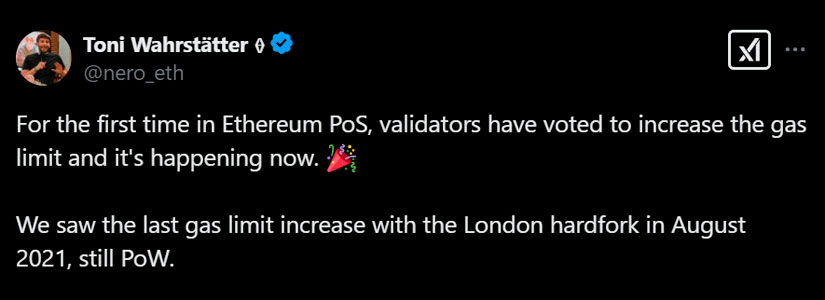TL;DR
- Ethereum has increased its gas limit for the first time since transitioning to proof-of-stake, enhancing transaction capacity without needing a hard fork.
- The gas limit has been raised from 30 million to over 31 million gas units, with plans to further increase to a maximum of 36 million gas units.
- This change improves network scalability, benefiting DeFi applications by reducing congestion and transaction costs, and was made possible through the consensus of Ethereum validators.
Ethereum has successfully increased its gas limit for the first time since transitioning to a proof-of-stake (PoS) consensus mechanism. This significant milestone was achieved after more than 50% of validators signaled their support for the change, allowing the network to enhance its transaction capacity without needing a hard fork.
Details of the Gas Limit Adjustment
The gas limit, which dictates the maximum amount of computational effort required to execute transactions or smart contracts within a single block, has been raised from 30 million to over 31 million gas units. This adjustment is expected to further increase to a maximum capacity of 36 million gas units. The last significant increase occurred in 2021 when the gas limit doubled from 15 million to 30 million gas units.
Impact on Network Scalability

Raising the gas limit allows Ethereum to process more transactions or more complex operations within each block, thereby improving network throughput. This change is particularly beneficial for DeFi applications, which require high transaction volumes and low latency. Higher gas limits also mean less congestion during peak times, reducing transaction costs and making the network more attractive to users.
Community and Validator Support
The decision to increase the gas limit was made possible through the consensus of Ethereum validators, who adjusted their node configurations to signal support for the change. This marks the first time such an adjustment has been implemented under Ethereum’s PoS mechanism, highlighting the network’s ability to adapt and scale without undergoing complex and risky hard forks.
Future Outlook and Upgrades
The increase in the gas limit is part of Ethereum’s broader efforts to scale the network. Upcoming upgrades, such as the Pectra upgrade, are expected to further enhance the network’s capacity by doubling the blob target from three to six, thereby improving the efficiency of layer-2 solutions.
These continuous improvements aim to maintain Ethereum’s position as a leading blockchain platform, capable of supporting a wide range of applications and services.











